-
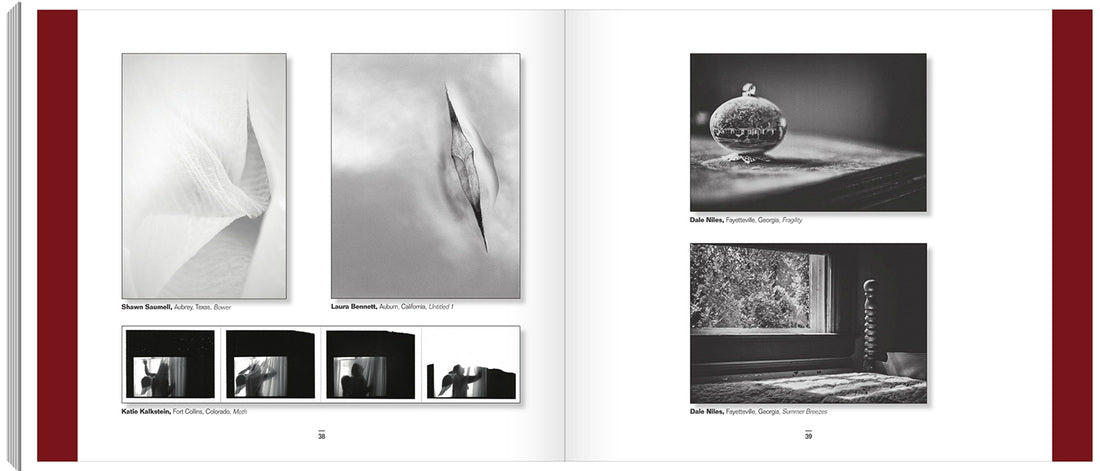
-
TPS 22: The International Competition | A Smith Gallery (and traveling)
Juror: Blue Mitchell, Founding Editor Diffusion Magazine, Curator Plates to Pixels Gallery
[exhibition catalogue, 2013-2014]
Juror's Statement:
In today's world that is fast paced and frenzied due to virtual connectivity and new media, there is a temporal quality to art and entertainment. Good or bad, photography has been severely influenced by new technologies and it is constantly changing and evolving.
Looking at the history of art - and the short history of photography - I can't help but wonder what history photo artists are creating today. I'm referring not so much about the tools of photography, but the actual images themselves.
What are we creating now that will be included in future photographic history classes?
For the TPS 22: International Competition, I'm interested in seeing work that has a timelessness to it - something that nods to the past, present and future of photography. I'd like to see work that challenges the observer to spend more than a fraction of time with its visual encoding, be it narrative, documentary, conceptual or just simple beauty.
[from the portfolio, A Ply]
-
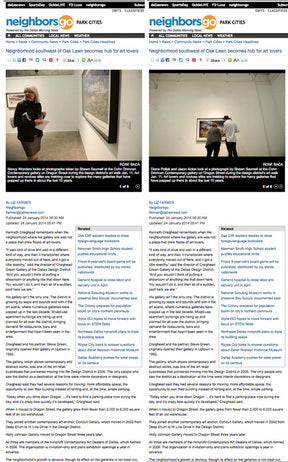
-
The Dallas Morning News
Art Critic: Liz Farmer
[newspaper, 2014]
This editorial explores the phenomenon of the gallery row in the Design District of Dallas. Photos of art goers viewing Shawn Saumell's exhibition at the Cohn Drennan Gallery are featured.
[from the portfolio, Earths]
-
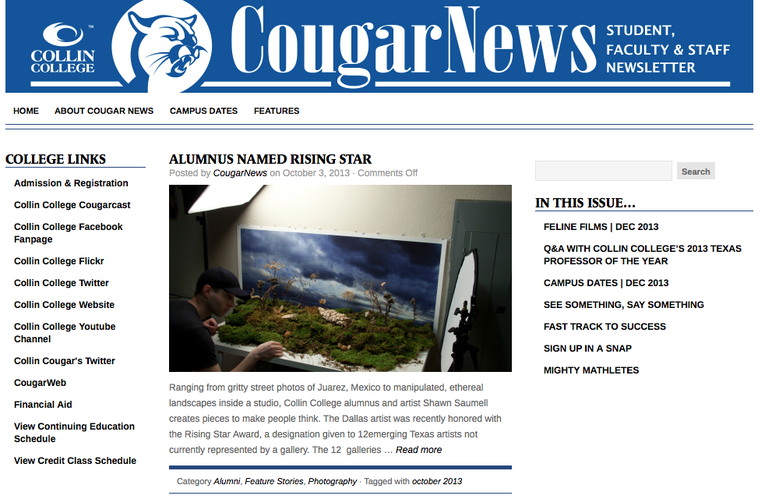
-
Collin College Cougar News
[from the portfolio, Earths]
-
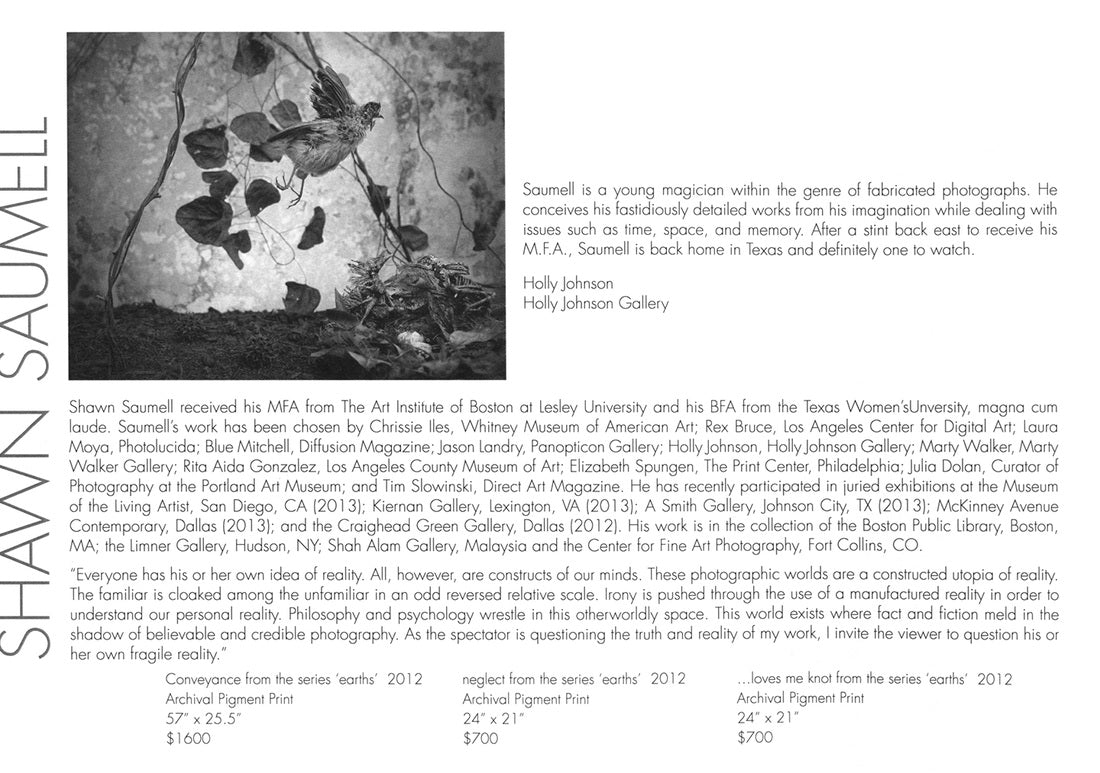
-
Rising Star | Turner House Gallery
Nominated: Holly Johnson, Holly Johnson Gallery
[exhibition catalogue, 2013]
Press Release:
Twelve prestigious Dallas galleries have each nominated one emerging Texas artist who is not yet represented by a gallery to be in the group show. Participating galleries are: Barry Whistler Gallery, Conduit Gallery, Craighead Green, Cris Worley Fine Arts, David Dike Fine Art, Galleri Urbane, Holly Johnson Gallery, Mary Tomás Studio Gallery, Photographs Do Not Bend, The Reading Room, Valley House Gallery and Sculpture Garden and Talley Dunn Gallery.According to artist Kenda North, co-chair of the event, the 100-year-old Turner House has a long history of showcasing Texas artists. “Rising Star” is an effort to continue that tradition and drawattention to some exciting new artists who are just beginning to gain attention in the art community,” she said.
[from the portfolio, Earths]
-
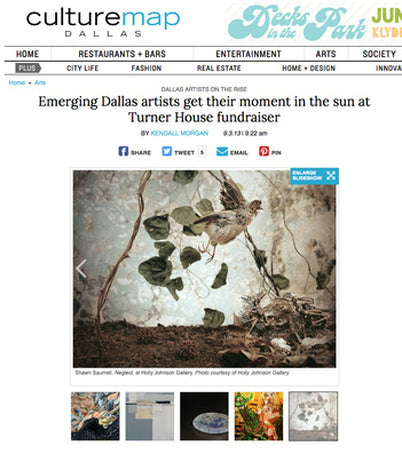
-
Dallas Culture Map
Critic: Kendall Morgan
[online magazine, 2013]
This is an article covering the "Rising Star" event and mentioning Shawn's participation and nomination by Holly Johnson.
[from the portfolio,Earths]
-
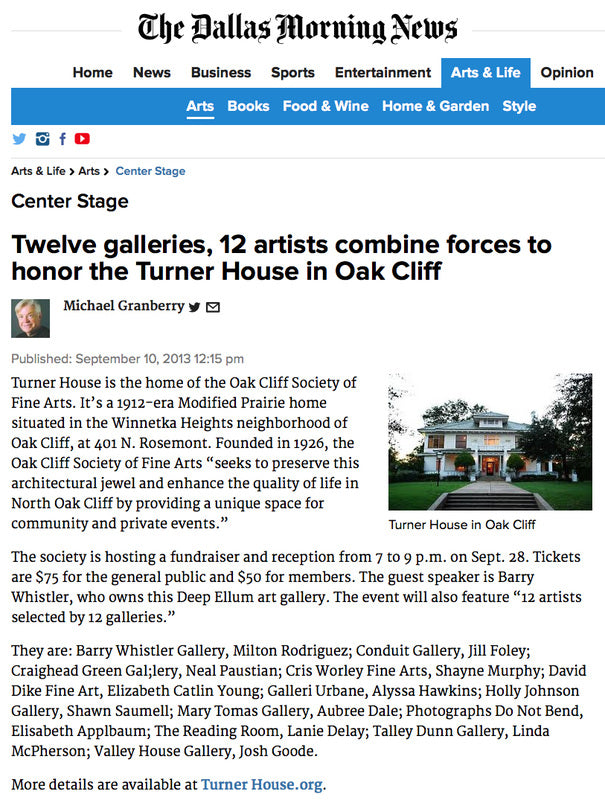
-
Dallas Morning News
Art Critic: Michael Granberry
[newspaper, 2013]
This article informs about the first annual "Rising Star" exhibition in Dallas. Twelve artists were chosen from twelve of Dallas' finest galleries. Shawn Saumell was chosen and nominated as a "Rising Star" by the Holly Johnson Gallery.
[from the portfolio, Earths]
-
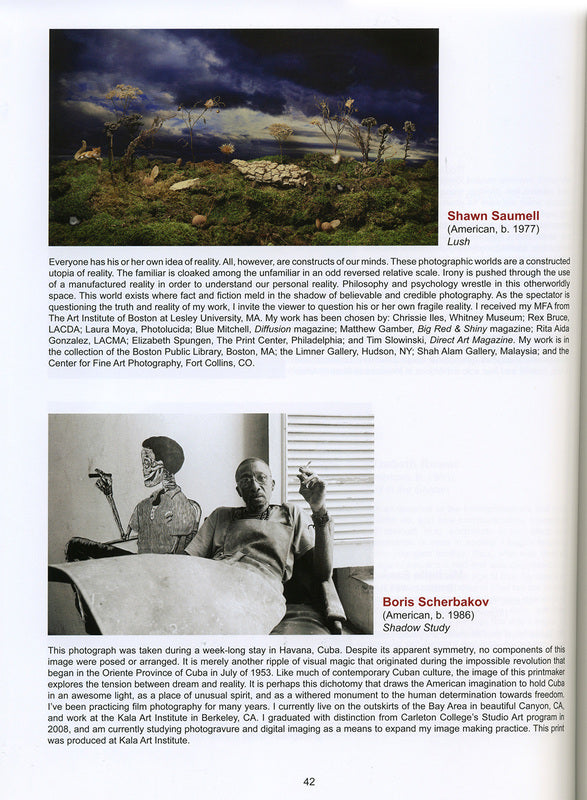
-
The Art of Photography Show | Museum of the Living Artist
Juror: Julia Dolan, The Minor White Curator of Photography, Portland Art Museum
[exhibition catalogue, 2013]
Judge's Forward:
People, places, and things. Photography is and should be that simple. I studied the history of photography for years and sometimes over-theorized the medium, occasionally losing sight of these building blocks. Eventually a wise mentor pointed out these straightforward but essential foundations. Without people, places, and things, the photographic image, which is knottily tied to reality (however we might interpret that term) and our visible world, does not exist. These days, whenever presented with new photographs, I begin with the people, the places, and the things. Strong photographs and the photographers who create them present these elements in ways that invite me to consider our world in a fresh and perhaps different way.
All curators have stylistic and subjective biases. It is our responsibility to acknowledge and move beyond these predispositions so that we don’t miss a critical point or a magical image. Many themes remain constant throughout photography’s trajectory, including the portrait, the landscape, the still life, and the abstraction, but expression of these subjects evolves over time, constantly requiring us to adjust our vision. An iPhone might create a visually perplexing image because its camera mechanics accidentally morph a straightforward scene into an otherworldly one. A photographer on the other side of the world can now transmit jpegs that illuminate daily life in a location long inaccessible to outsiders. Or perhaps an artist catches something out of the corner of his or her eye, sharing that unique vision with us and demonstrating how everything that occurs in the visible world, though seemingly concrete and indisputable, is subject to interpretation.
While moving through the almost 13,000 entries submitted to The Art of Photography Show, I sought out photographs representing a wide range of subjects and approaches landing on all parts of the emotional spectrum. I found photographs made in tiny studios and the expansive outdoors. I circled back to works that challenged me through subject matter and composition, as well as those that immediately struck me as delightful or touching. Surprisingly, reducing the group to 600 photographs was not particularly burdensome. Narrowing the selections from 600 to the final 200, however, was often painful.
Photographs tell small parts of larger stories with an immediacy unlike other art forms, and the many images submitted to the Show from around the world underscore this phenomenon. Hossein Fatemi’s outstanding portrait of a man who lost his leg to a landmine is straightforward, poignant, rich with meaning, and even surreal. It uses elements of the established language of photography—the professional studio’s background fabric sweep, the frontal pose—but adds the incongruous element of the potted plant. The prosthetic leg points to a violent and unpredictable world beyond the deep blue fabric, while the man it supports demonstrates the fierce determination needed to survive outside of this controlled space. Similarly powerful is Mark Esper’s portrait of an Iranian hunger striker. The string that physically and symbolically seals the man’s lips is an exquisite detail, quietly expresses pain and protest as well as beauty. Denis Gillingwater’s stark, pixelated photograph, though created recently, is surprisingly reminiscent of Joseph Nicéphore Niépce’s image from his window at Le Gras. Surely Niépce, who created the “first photograph” almost two hundred years ago, could not have foreseen the medium’s potential for the constant surveillance and evidence compilation now underway. And just what, exactly, is that liquid in Jason Olive’s sumptuous image, and where is it? Milk in a bowl? Paint in a can? Water in an ocean? I don’t care, I want to climb into the photograph and be enveloped. I want to be enveloped by all of these photographs.
This is why the range of photographs submitted to the show is enthralling. As I move from photograph to photograph I am reminded of my childhood one moment, of a seventeenth-century painting the next. I see that the world is a complicated and often painful place and then marvel at striking composition and color and design. I hope these images stir up similar—or completely unrelated—thoughts and feelings in you. This is photography. It is glorious. It is very simply and most magnificently made up of people, places, and things.
[from the portfolio, Earths]
-
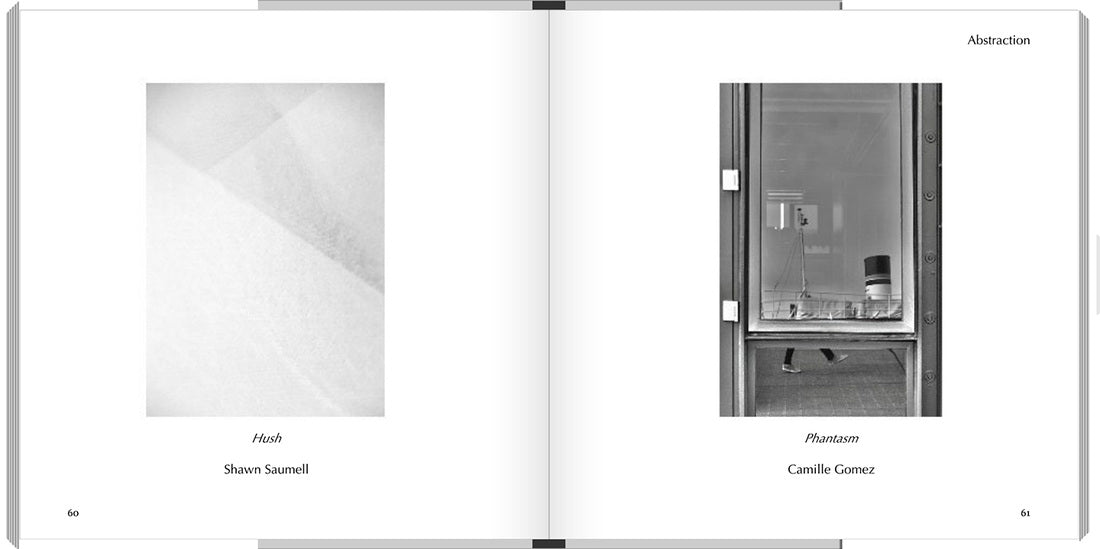
-
Abstraction | The Kiernan Gallery
Juror: Matthew Gamber, Boston-based Artist and Critic
[exhibition catalogue vol.xvi, 2013]
Juror's Statement:
In taking a broad approach to the idea of abstraction, I selected images that took a certain element of risk in their visual approach. What was considered abstract only a couple of years ago has been absorbed into our visual language as artists (and as viewers). Abstraction, when utilized as an aesthetic principle in art, should not be easily recognized as art. As an aesthetic, abstraction is a moving target. If a particular aesthetic becomes collectively understood, and accepted as art (becoming a style, or trend), it no longer offers a divergent viewpoint.
I have tried to consider how certain images can resonate with viewers even if the subject matter of the photograph is not readily apparent. It requires a kind of evaluation that might not be required by artwork with subject-based content. As a juror, I identified with work whose content, scale, and materiality were not immediately recognizable. The variations were many; the final choice was difficult. For me, the most successful pieces were ones that focused on the idea of abstraction as a subtractive process, rather than additive. By removing information from concrete origins, one are left with a tenuous attachment to the original subject matter, generating the variations you now see in these images.
[from the portfolio, A Ply]
-
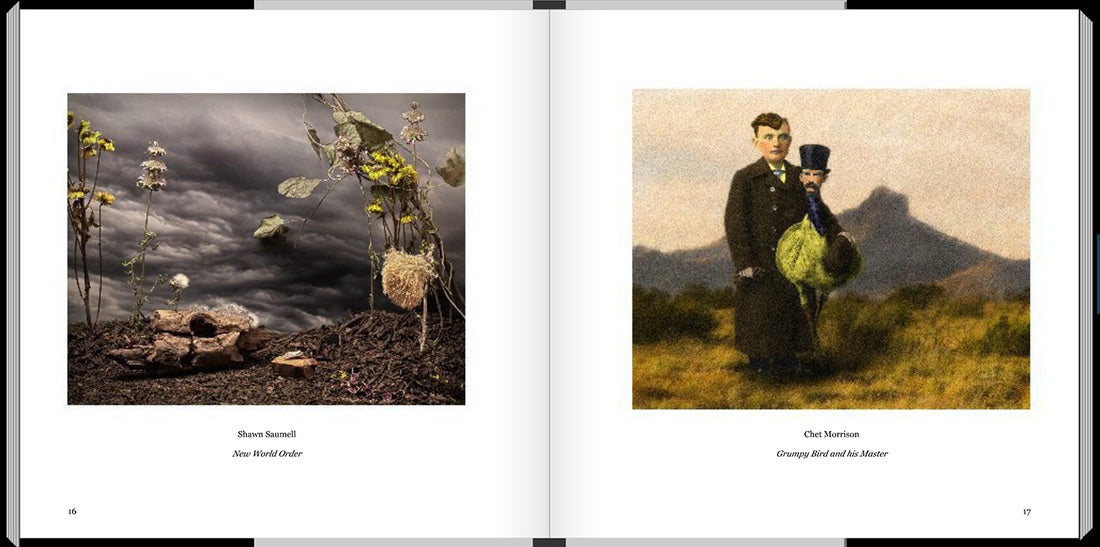
-
Alternative Realities | PhotoPlace Gallery
Juror: Laura Moya, Executive Director Photolucida
[exhibition catalogue, 2012]
Juror's Statement:
To define the term “Alternate Realities” would be a difficult task, so I will make reference to a few vocabulary words that passed through my mind while looking at the work submitted to this exhibition: …’imagination’, ‘memory’, ‘parallel dimension’, ‘personal dreamstate’, ‘collective subconscious’, even ‘quantum physics’…The work that proved strongest to me was that which did not default to the obvious or the clichéd. Evolved work with a clear connection to the theme combined with strength to stand on its own as an image became clearer through many rounds of winnowing.My hope is that a lively narrative will show itself in a consistent, thought-provoking way when the work is collectively shown together as a group.I feel honored to have travelled through such varied, creative interpretations of this topic.[from the portfolio, Earths]
-
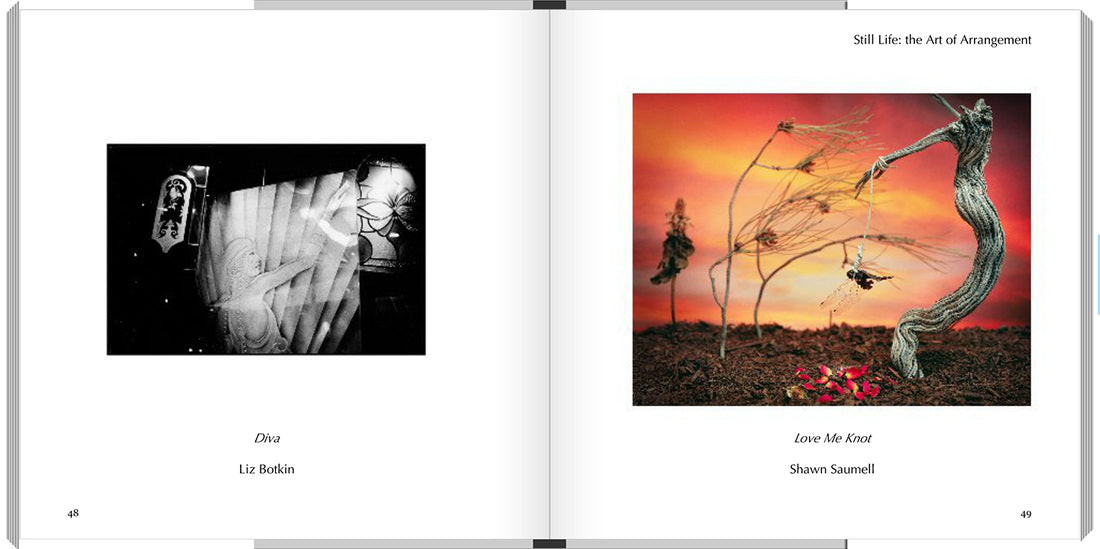
-
Still Life: The Art of Arrangement | The Kiernan Gallery
Juror: Jason Landry, Owner/Director Panopticon Gallery
[exhibition catalogue vol.x, 2012]
Juror's Statement:
When I think of the term 'still life', I immediately think of props set up for painters. Particularly, what comes to mind is my favorite still life painting calledOld Models, painted by William Harnett in 1892. It is a fabulous oil painting that is part of the Museum of Fine Art Boston collection.
Now, why am I talking about painting when I just juried a photography-themed exhibition? Well, this particular painting that I speak of is so realistic, that from a distance one might mistake it for a photograph.
I also think about the Japanese tradition of Ikebana when I hear 'still life'. Ikebana is more than just the art of floral arranging, it is a way of personal expression and each arrangement is well thought out - bringing life to the still compositions.
What I'd like to point out, is that photographers have been pointing their lenses at objects since the mid-1800's and everything, whether it is a landscape, a person, a flower, or building is eventually frozen, captured in a fraction of a second and suspended into something that is still - a still image. Photographers do not always have to set up something on a tabletop to call it a still life - think about it. All you have to do is look, compose something through the viewfinder of your camera, and then click the shutter release.
As you will see through the selected works in this exhibition, my taste runs the gamut. I was attracted to the comedic, such as the dinosaurs lining the edge of the bathtub, to how the pins cast a shadow across the women's face in photographSpoke Stitched. From the abstract, vintage erotic stimulation mechanisms, to the cinematic feel of the flowing curtain in the imageOval Mirror. There was something very touching in the imageStill Life with Glass Bottleand the imageLow Hanging Fruitwas beautifully done and evokes a touch of Mapplethorpe.
[from the portfolio, Earths]
-
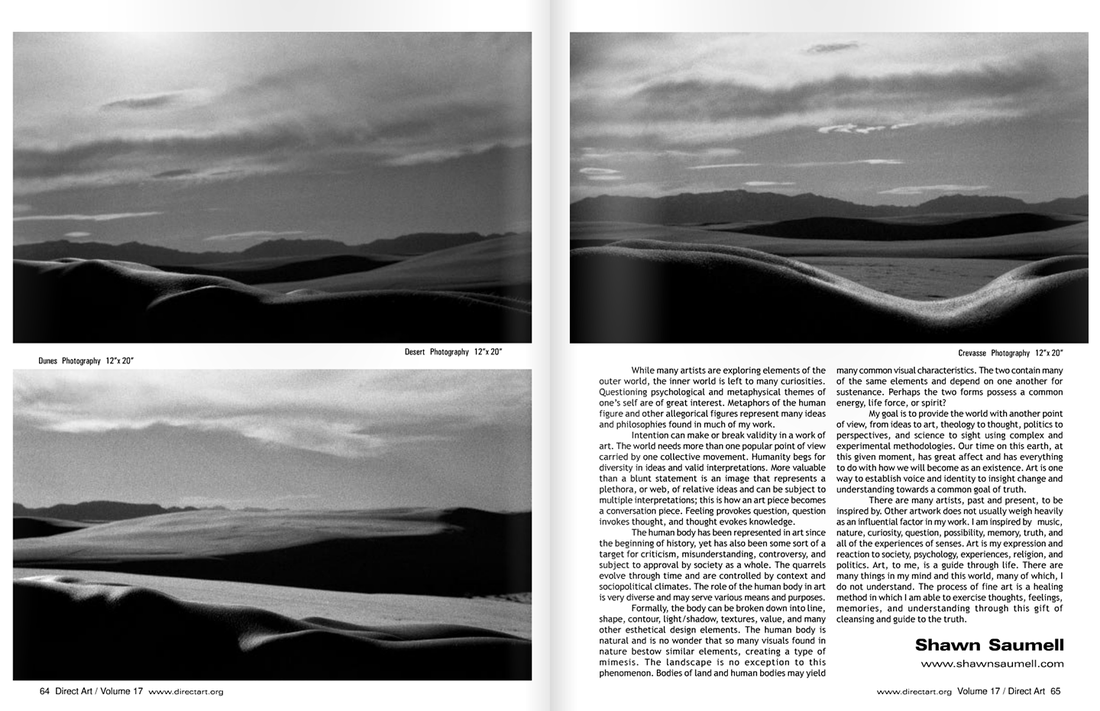
-
Direct Art Magazine
Editor: Tim Slowinski
[magazine, 2010]
From an international call for artists competition, Shawn Saumell's body in the landscape won First Place. As part of the award, his work received a two-page spread in Direct Art Magazine.
[from a stand alone short series of human landscape]
-
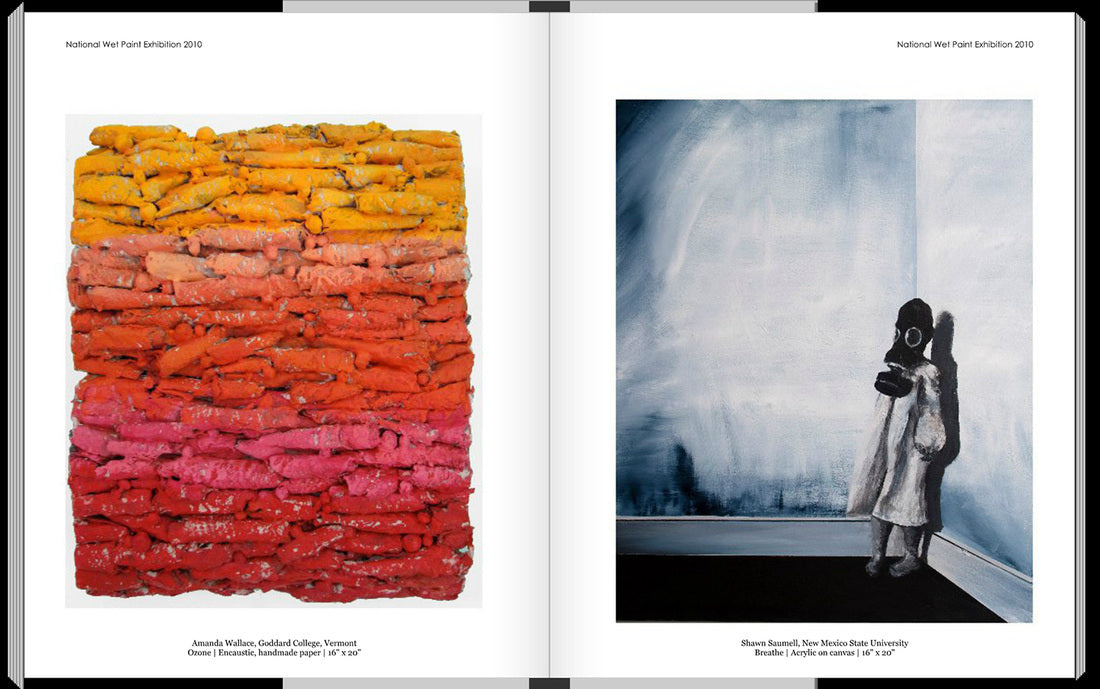
-
National Wet Paint | Zhou B Art Center
Juror: Sergio Gomez
[exhibition catalogue, 2010]
About the Exhibition:
The National Wet Paint Exhibition is an outlook and an overview of emerging contemporary artists across the United States currently working in the medium of painting. Wet Paint refers to the idea that this is a fresh group of artists. They are MFA (Masters of Fine Arts) candidates and recent MFA recipients working primarily in the medium of painting.
2010 marks the first decade of the 21st Century. Under the watchful eye of a technology driven society, online social networking and cyber interaction communities, emerging artists have been evolving and redefining one of the oldest mediums of art, painting.
The National Wet Paint Exhibition consists of 52 paintings by artists selected from a national call which resulted in 255 submissions. The exhibition takes place in the 6000 square feet main gallery of the Zhou B Art Center in Chicago's Bridgeport neighborhood. The Zhou B Art Center is a private, non-government funded art center designed to facilitate the exchange of contemporary art between Chicago and the international art community. The 87,000 square feet art center offers innumerable possibilities for exploring the arts in a charismatic location and collectively form an extravagant art center fusing culture and creativity.
[from a stand alone painting]
-
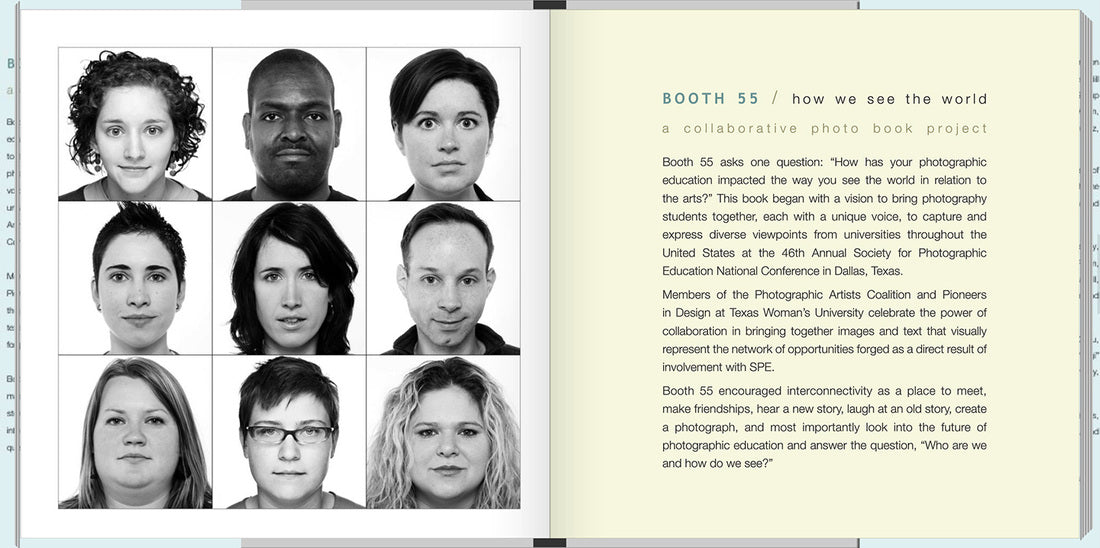
-
Booth 55 / how we see the world
Texas Woman's University
[book, 2010]
Introduction:
Booth 55 asks one question: “How has your photographic education impacted the way you see the world in relation to the arts?” This book began with a vision to bring photography students together, each with a unique voice, to capture and express diverse viewpoints from universities throughout the United States at the 46th Annual Society for Photographic Education National Conference in Dallas, Texas.
Members of the Photographic Artists Coalition and Pioneers in Design at Texas Woman's University celebrate the power of collaboration in bringing together images and text that visually represent the network of opportunities forged as a direct result of involvement with SPE.
Booth 55 encouraged interconnectivity as a place to meet, make friendships, hear a new story, laugh at an old story, create a photograph, and most importantly look into the future of photographic education and answer the question, "Who are we and how do we see?"
[from a collaborative group project]
-
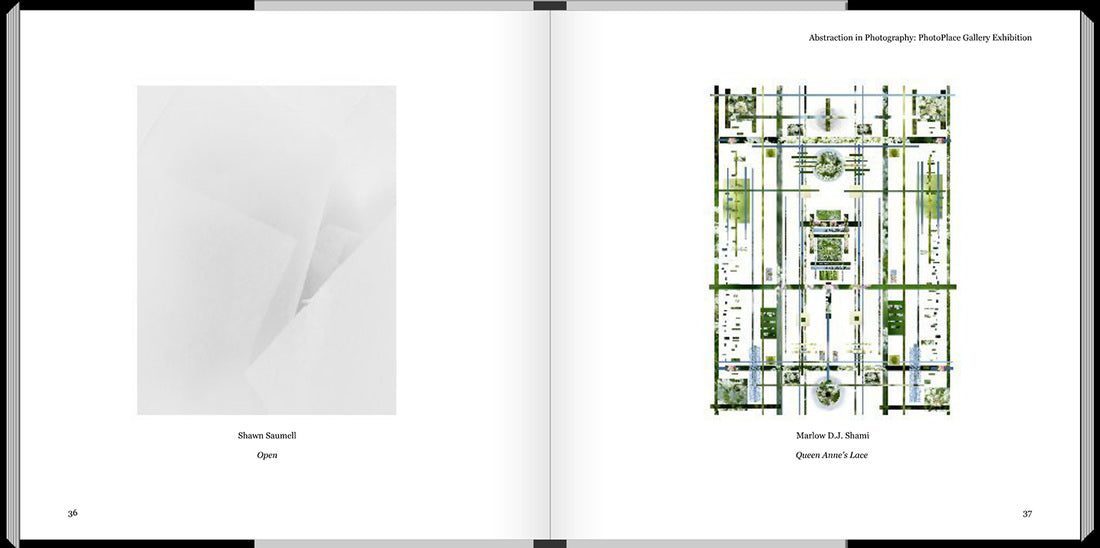
-
Abstraction in Photography | PhotoPlace Gallery
Juror: Stephen Strom, Photographer, Author, Astronomer
[exhibition catalogue, 2010]
Director's Statement:
The call for submissions for the juried exhibition Abstraction in Photography resulted in over 1300 photographs by over 200 photographers. Juror Stephen Strom selected forty works for exhibition at PhotoPlace Gallery in Middlebury, Vermont. He also chose an additional 35 images for inclusion in the gallery's On-Line Annex. All 75 photographs are illustrated in this catalogue.
In his juror's remarks, Stephen Strom observed that the difficulty of selecting 75 images from such a large group of submissions was mitigated by the high quality of much of the work and the wide range of imaginative approaches taken by the artists. He noted that work ranged from found patterns in the natural environment, to imaginative references to a variety of other twentieth-century artists, to creative uses of photographic techniques, to color and textural transformations, to restricted tonal ranges, multiple exposures and repeated patterns, and the use of light and shadow to create emotionally evocative patterns.
He also noted that the photographs included span a full range of techniques, from classical black and white imaging, to subtle color images, to vibrant constructed photographs.
- Kirsten Hoving and Rick Clark
[from the portfolio, A Ply]
-
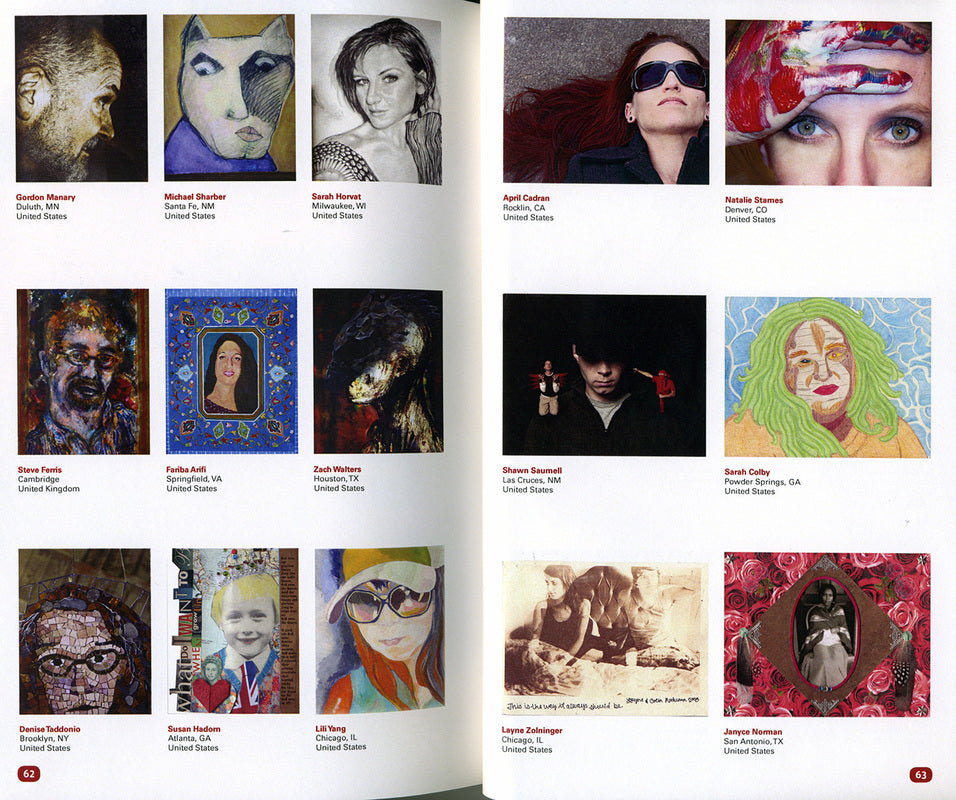
-
Self Portrait Project | Art House Co-op
Organizer: Steven Peterman
[exhibition catalogue, 2010]
Project Statement:
What does our creative community look like? How do you see yourself when you close your eyes? The Self-Portrait Project is an opportunity to introduce yourself to the world — one canvas at a time. Whether you feel challenged to depict yourself in photographic detail or to abstract your personality in visual form. The resulting wall of portraits will open thousands of windows into our community, sharing something about ourselves for the entire world to see.
-
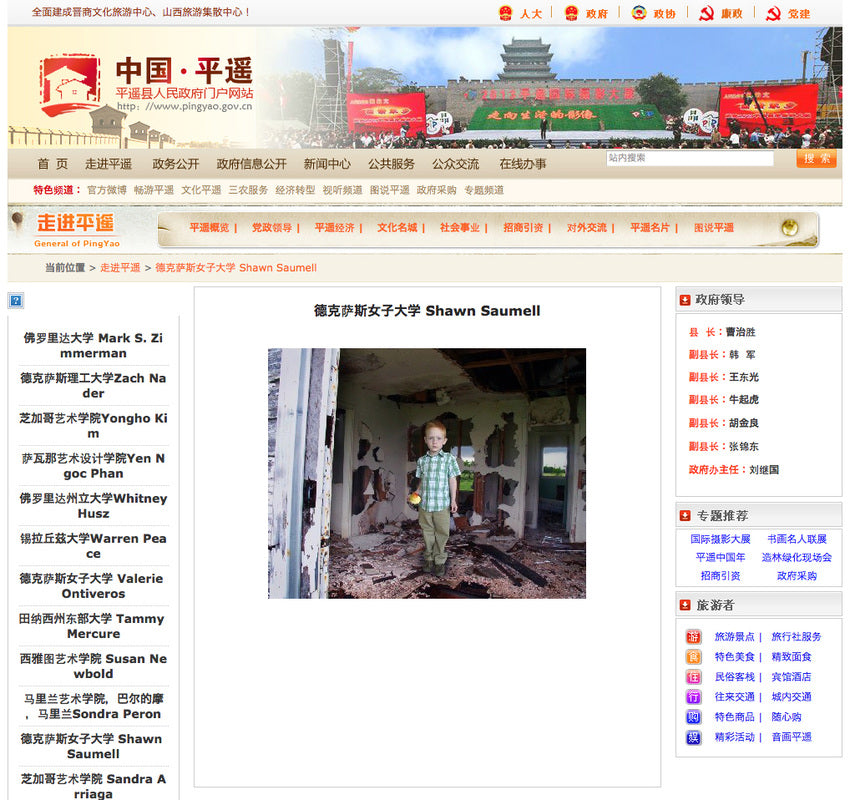
-
Pingyao China Photo Festival
-

-
A Lot to Say: a lot of nothing to say, Codex: IAuthor & Illustrator: Shawn Saumell
[handmade one-of-a-kind and limited first edition of 500, 2008
casebound, hardcover, fine cloth, 80 pages
6" x 9"]
ISBN-10: 061540135X
ISBN-13: 978-0615401355
Colophon:
This handbound edition of, “A Lot to Say: Codex I was written over the years of 2003 and 2004 and constructed in 2008. All images, literature, and book construction and design are the original work and concepts of Shawn Saumell under the guidance of Susan kae Grant.
The literature was written before the photographs were conceived. The writing was the result of hypnagogic hallucinations and meditation between the years of 2003 and 2004. In the fall of 2006, visual concepts were photographed on Kodak Elite Chrome 100 slide film to illustrate the writing. By the end of 2006, the slides were exposed to Polaroid sheet film type 59 and transferred to watercolor paper. For this edition of Codex I, all of the slides were exposed to Polaroid type 669 sheet film and then transferred directly onto the book’s Johannot 125g pages.
-
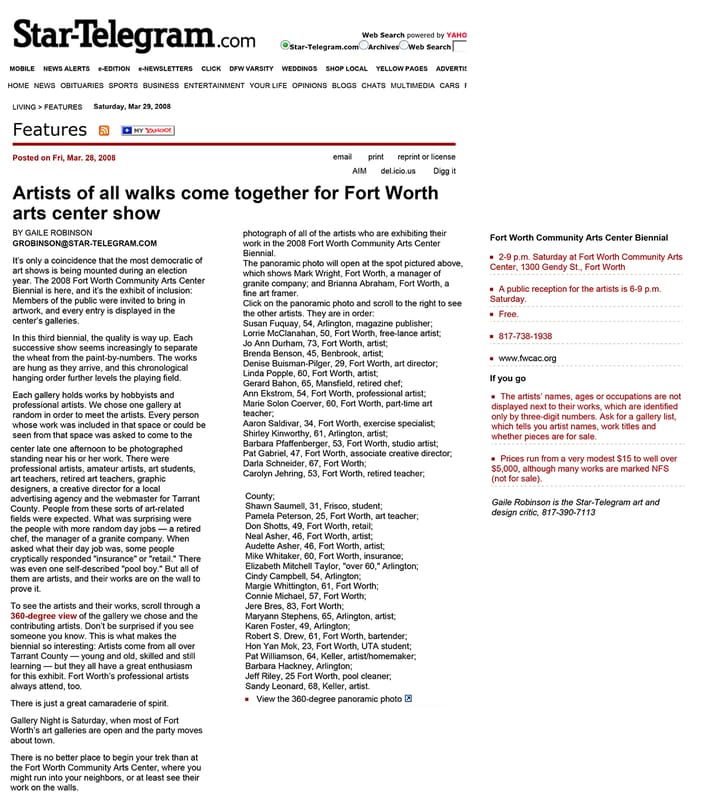
-
Fort Worth Star Telegram
Writer: Gayle Robinson
[newpaper, 2008]
-
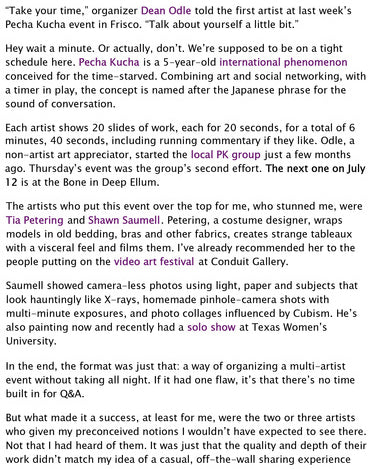
-
KERA Art & Seek
Writer: Manny Mendoza
[online news, 2008]
Shawn was featured in this article covering a Pecha Kucha event in Frisco, TX, hosted by Dean Odle. See article below.
-

-
REaD
Author & Illustrator: Shawn Saumell
[handmade book, limited edition of 10, 2008
casebound hardcover, 35 pages
5.25" x 7.75"]
Artist Statement:
Vastly exploited and thoroughly unexplored, red is one of the three primary colors from which all other colors derive. There are many esoteric qualities within this powerful color. It is no wonder that Newton discovered some of the importance of this color’s properties after dissecting white light with a prism. Also, Goethe placed red at the top of his color wheel. It’s the farthest color in the light spectrum, having the longest wavelength of all colors, and being the fastest to reach the eye. This color causes physical, metaphysical, and psychological effects, from increasing blood pressure and metabolism, to inciting fear and caution. These may be some of the qualities that Hitler became so fond of, to consciously and intentionally abuse, and again later by the most powerful street gang in North America, the Bloods. Throughout history red has been misunderstood, used, and abused, as it has always been ever-present in nature and humankind. Whatever remains of what we believe to know, there is still much to be examined by the unseen eye just as one of many keys to understanding. - Shawn Saumell
The illustrations are original graphic designs and photography applied to each page by method of solvent transfer; all text is solvent transfer as well, on Stonehenge fine paper. The cover is hardback with fine French velvet flocked laval bookcloth and blind embossed title. All materials are acid-free.
-
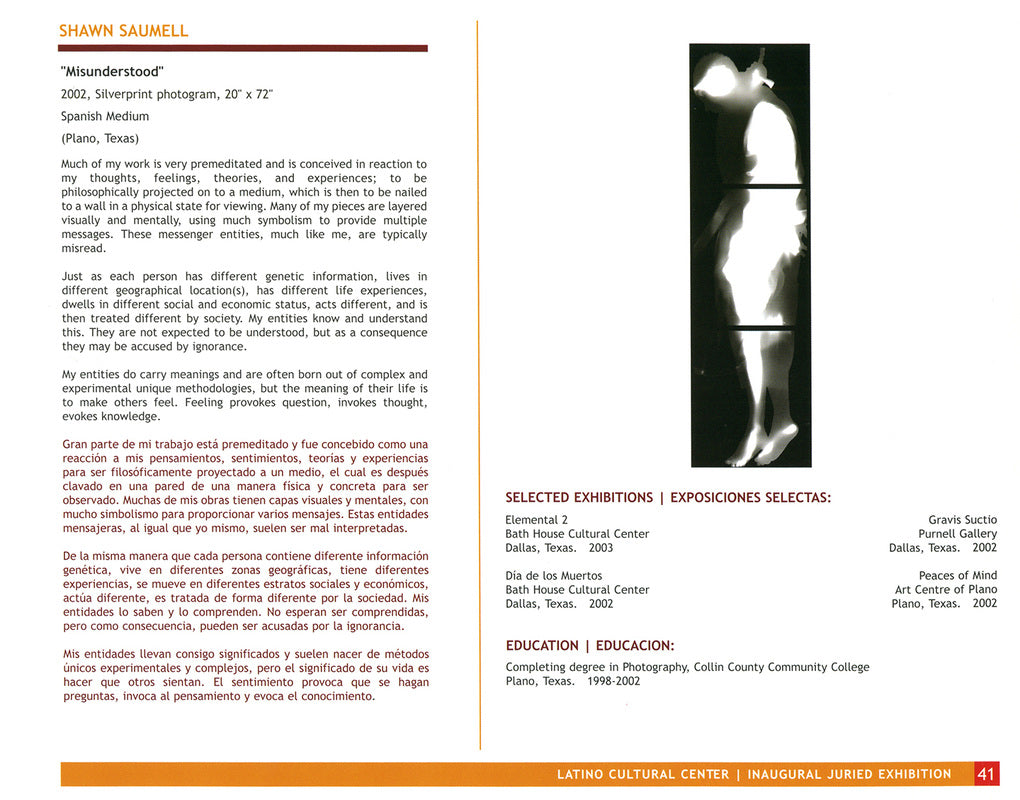
-
Inaugural Exhibition | Latino Cultural Center
Jurors: Dr. Shifra M Goldman, Latin American Center at UCLA, Author
Tere Romo, Executive Director MACLA (Movimiento de Arte y Cultura Latino Americana),
Curator Mexican Museum, Arts Director Mexican Fine Arts Center Museum Chicago
Dr. Tomás Ybarra-Frausto, Chair of the Board Mexican Museum, Chair of Smithsonian Council
[exhibition catalogue, 2003]
Artist's Statement:
Much of my work is very premeditated and is conceived in reaction to my thoughts, feelings, theories, and experiences; to be philosophically projected on to a medium, which is then to be nailed to a wall in a physical state for viewing. Many of my pieces are layered visually and mentally, using much symbolism to provide multiple messages. These messenger entities, much like me, are typically misread.
Just as each person has different genetic information, lives in different geographical location(s), has different life experiences, dwells in different social & economic status, acts different, and is then treated different by society. My entities know and understand this. They are not expected to be understood, but as a consequence they may be accused by ignorance.
My entities do carry meanings and are often born out of complex and experimental unique methodologies, but the meaning of their life it to make others feel. Feeling provokes question invokes thought evokes knowledge.
[from the portfolio, Peaces of Mind]
-
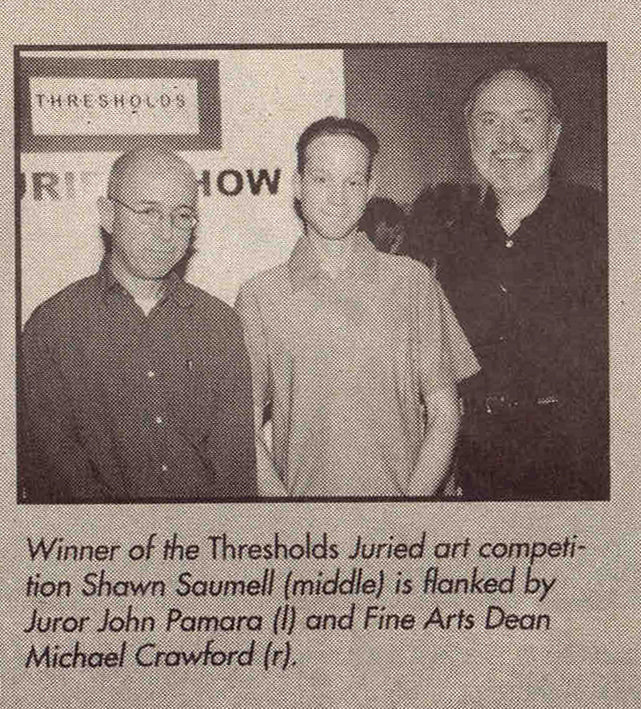
-
Caleidoscope newspaper
featured article
[newspaper, 2001]
Shawn was featured in this newspaper after winning "Best of Show" in the Thresholds juried competition and winning his first solo-exhibition and a stipend.
[from a stand alone piece]





















